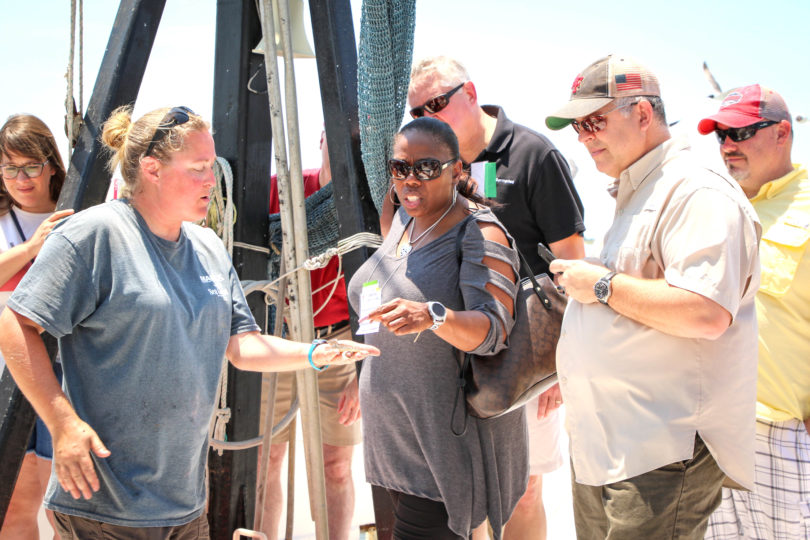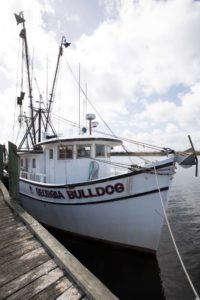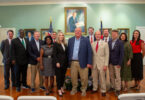Economic development professionals from Georgia’s inland counties got a firsthand look at University of Georgia Marine Extension and Georgia Sea Grant operations in Brunswick, and learned how work done there affects the rest of the state.
Sean McMillan, director of UGA’s Atlanta-based office of economic development, accompanied 23 members of the Georgia Economic Developers Association to Brunswick in May. McMillan organizes the tour to connect businesses and communities across Georgia to UGA’s economic development efforts on the coast.
“This tour impresses upon the economic development community in Georgia all of the wonderful work that Marine Extension and Georgia Sea Grant does for our coastal communities,” said McMillan. “Faculty and staff here provide the underpinnings for successful businesses and vibrant communities.”
The visit included a trawl on the Georgia Bulldog, UGA’s 72-foot research vessel. During the trip on St. Simons sound, Marine Extension and Georgia Sea Grant Director Mark Risse told the group that his faculty and staff support sustainable commercial fisheries and explore options, such oyster aquaculture, to diversify the coastal economy.
“We are working with shellfish growers to study methods to make farming oysters easier and hopefully attract new farmers,” Risse said. “We’re also training commercial fishermen on how to collect data on black gill, a condition impacting Georgia shrimp.”
In 2015, Marine Extension and Georgia Sea Grant launched an oyster hatchery at the UGA Shellfish Research Center Lab on Skidaway Island. Extension agents at the hatchery create oyster spat (baby oysters), which they give to local shellfish farmers to grow out. The hatchery has distributed 1.4 million spat to farmers since 2015. With a change in regulations that would allow the use of proper equipment to farm the oysters, marine extension agents predict they could produce 15 million spat at full capacity, with an estimated harvest value of $3.75 million to $5.2 million.
The total value of Georgia’s commercial seafood landings in 2017 was $16.8 million, according to the Georgia Department of Natural Resources.
In addition to fishing and aquaculture, the seafood industry creates jobs in the service sector, such as hotels and restaurants that draw tourists, who spend money, boosting the local economy.
“The work with the seafood industry directly relates to economic development in so many ways,” said Pat Merritt, GEDA vice chair and president of community and economic development for the Georgia Electric Membership Corp. “There’s a job creation aspect to it and that’s what we’re all about; creating jobs and investment.”
In addition, GEDA members learned that specialists with Marine Extension and Georgia Sea Grant partner with local governments to improve stormwater management and plan for coastal hazards. They also promote healthy coastal ecosystems through education and outreach focused on reducing marine debris and improving water quality.
“It’s interesting to hear about all the different areas (UGA) works in,” said Megan Baker, business retention and expansion project manager at the Fayette County Development Authority. “We’re fortunate to have this program here because it supports economic development as well as the people and the coast.”
The Georgia Economic Developers Association is a nonprofit association of professionals and volunteers who are involved with the economic development of the cities and counties of Georgia. GEDA was organized to increase the effectiveness of individuals involved in the practice of economic development in Georgia by encouraging cooperation, exchanging information and upgrading professional skills.









